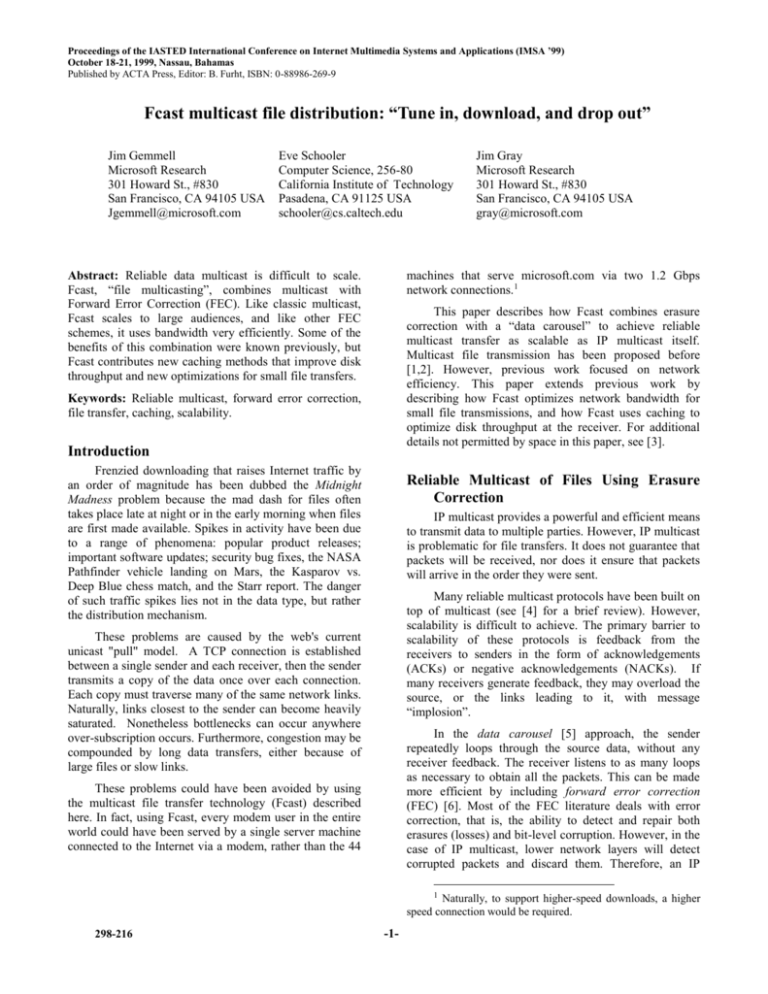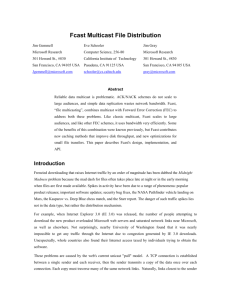Fcast multicast file distribution:
advertisement

Proceedings of the IASTED International Conference on Internet Multimedia Systems and Applications (IMSA ’99)
October 18-21, 1999, Nassau, Bahamas
Published by ACTA Press, Editor: B. Furht, ISBN: 0-88986-269-9
Fcast multicast file distribution: “Tune in, download, and drop out”
Jim Gemmell
Microsoft Research
301 Howard St., #830
San Francisco, CA 94105 USA
Jgemmell@microsoft.com
Eve Schooler
Computer Science, 256-80
California Institute of Technology
Pasadena, CA 91125 USA
schooler@cs.caltech.edu
Abstract: Reliable data multicast is difficult to scale.
Fcast, “file multicasting”, combines multicast with
Forward Error Correction (FEC). Like classic multicast,
Fcast scales to large audiences, and like other FEC
schemes, it uses bandwidth very efficiently. Some of the
benefits of this combination were known previously, but
Fcast contributes new caching methods that improve disk
throughput and new optimizations for small file transfers.
Jim Gray
Microsoft Research
301 Howard St., #830
San Francisco, CA 94105 USA
gray@microsoft.com
machines that serve microsoft.com via two 1.2 Gbps
network connections.1
This paper describes how Fcast combines erasure
correction with a “data carousel” to achieve reliable
multicast transfer as scalable as IP multicast itself.
Multicast file transmission has been proposed before
[1,2]. However, previous work focused on network
efficiency. This paper extends previous work by
describing how Fcast optimizes network bandwidth for
small file transmissions, and how Fcast uses caching to
optimize disk throughput at the receiver. For additional
details not permitted by space in this paper, see [3].
Keywords: Reliable multicast, forward error correction,
file transfer, caching, scalability.
Introduction
Frenzied downloading that raises Internet traffic by
an order of magnitude has been dubbed the Midnight
Madness problem because the mad dash for files often
takes place late at night or in the early morning when files
are first made available. Spikes in activity have been due
to a range of phenomena: popular product releases;
important software updates; security bug fixes, the NASA
Pathfinder vehicle landing on Mars, the Kasparov vs.
Deep Blue chess match, and the Starr report. The danger
of such traffic spikes lies not in the data type, but rather
the distribution mechanism.
Reliable Multicast of Files Using Erasure
Correction
IP multicast provides a powerful and efficient means
to transmit data to multiple parties. However, IP multicast
is problematic for file transfers. It does not guarantee that
packets will be received, nor does it ensure that packets
will arrive in the order they were sent.
Many reliable multicast protocols have been built on
top of multicast (see [4] for a brief review). However,
scalability is difficult to achieve. The primary barrier to
scalability of these protocols is feedback from the
receivers to senders in the form of acknowledgements
(ACKs) or negative acknowledgements (NACKs). If
many receivers generate feedback, they may overload the
source, or the links leading to it, with message
“implosion”.
These problems are caused by the web's current
unicast "pull" model. A TCP connection is established
between a single sender and each receiver, then the sender
transmits a copy of the data once over each connection.
Each copy must traverse many of the same network links.
Naturally, links closest to the sender can become heavily
saturated. Nonetheless bottlenecks can occur anywhere
over-subscription occurs. Furthermore, congestion may be
compounded by long data transfers, either because of
large files or slow links.
In the data carousel [5] approach, the sender
repeatedly loops through the source data, without any
receiver feedback. The receiver listens to as many loops
as necessary to obtain all the packets. This can be made
more efficient by including forward error correction
(FEC) [6]. Most of the FEC literature deals with error
correction, that is, the ability to detect and repair both
erasures (losses) and bit-level corruption. However, in the
case of IP multicast, lower network layers will detect
corrupted packets and discard them. Therefore, an IP
These problems could have been avoided by using
the multicast file transfer technology (Fcast) described
here. In fact, using Fcast, every modem user in the entire
world could have been served by a single server machine
connected to the Internet via a modem, rather than the 44
1
Naturally, to support higher-speed downloads, a higher
speed connection would be required.
298-216
-1-
multicast application need not be concerned with
corruption; it can focus on erasure correction only.
Fcast assumes that a single sender initiates the
transfer of a single file to a multicast address. The sender
loops continuously either ad infinitum, or until a certain
amount of FEC redundancy has been achieved. Receivers
tune in to the multicast address and cache packets in a
temporary file name until they receive enough blocks to
recreate the file. At that point, the file is then decoded,
and the file name and attributes set. See Section 0 for
more details of the reception algorithm.
The erasure correction used here is called an (n,k)
code. k source blocks are encoded into n>k blocks, such
that any k of the encoded blocks can be used to
reconstruct the original k blocks (Figure 1). For example,
parity can be used to implement (k+1, k) encoding. Many
(n,k) codes based on Reed-Solomon codes are efficient
enough to be used by personal computers [7,8,9]. Fcast
uses a systematic encoding, in which the first k of the n
encoded blocks are the original blocks. If these first k
blocks are received, no decoding is necessary.
Index
1
2
Original packets
1 2
...
k
encode
k
1 2
...
k
k+1
...
k+1
n
take any k
n
...
1
...
G
3
Group
decode
Original packets
2
Figure 2. Transmission order: Any k blocks must be received from each
group to reconstruct the transmitted file
1 2
...
k
Each file sent is given a unique ID, and each group
has an ID according to its offset from the start of the file.
Thus, each block in the transmission is identified by a
unique <File-ID, Group-ID, Index> tuple. Packets with
indices 0 to k-1 are original file blocks, while the packets
with indices k to n-1 are encoded blocks. The file ID,
group ID, and index are included in the packet header.
Figure 1. An example of (n,k) encoding and decoding: k original
packets are reconstructed from any k of the n encoded packets.
In practice, k and n must be limited for ReedSolomon based codes as large values make encoding and
decoding expensive. (k,n) = (64, 255) are typical limits
[1]. As most transmissions (e.g., files) are longer than k
blocks, they must be divided into groups of k blocks each,
with erasure correction (EC) performed on a group-bygroup basis. Each block in the session is assigned to an
EC group of k blocks, which is then encoded into n
blocks. Each block is identified by an index specifying
which of the n encoded blocks it is, as well as a group
identifier associating it with an EC group.
Our implementation makes the assumption that all
packets are the same fixed size.
Selecting a value for k
To complete the reception, k distinct blocks (i.e.,
with different index values) must be received from each
group. For some groups, more than k blocks may be
received, in which case the redundant blocks are
discarded. These redundant blocks are a source of
inefficiency, as they increase the overall reception time.
Thus, the inefficiency is related to the number of groups
G, which is the file size divided by k. Thus, larger k
values generally result in more efficient transfers.
However, implementation details prevent construction of
a codec with arbitrarily large k. Let the maximum possible
value of k be kmax. This section explains how to select an
optimal k, given that k can be at most kmax.
To complete the reception, k distinct blocks (i.e.,
with different index values) must be received from each
group. To ensure the minimum wait for a block from a
particular group, all blocks with index i are sent before
any blocks with index i+1. As shown in Figure 2, when
block n of the last group of the last file is sent, the
transmission cycles. One danger with this transmission
order is that a pattern of periodic network losses may
become synchronized with the transmission so as to
always impact blocks from certain groups; in the worst
case, a single group is always impacted. The impact of
periodic losses may be eliminated through randomly
permuting the order of groups sent for each index [10].
Thus, periodic losses are randomly spread among groups.
With this limit on k, larger files are transmitted less
efficiently (see [3] for more analysis). However, at the
other end of the spectrum, small transfers also require a
careful consideration of k value. For instance, transmitting
a 17 block file with k = 32 would require 15 padding
-2-
blocks to fill out the single group Recall, however, that
larger k values only improve efficiency by reducing the
number of groups. Therefore, using k=17, avoids the
overhead of padded blocks, and has the same efficiency as
k=32, since there is still be only one group. Therefore,
any transmission of S kmax should use k=S.
d
d
1
S dk max r k max r / d
Therefore, the fraction of waste due to padding will
always be less than 1/ kmax. Figure 5 shows the padding
overhead for files from size 0 to 2500 blocks, with
kmax=32.
Transmissions of slightly larger values are also
problematic. Assume for the moment that k must be fixed
over all groups in a file. Consider a transfer of kmax + 1
blocks. Using k= kmax would give one full group of k
blocks, and a second group containing only one data
block with k-1 empty padding blocks. The overhead of the
transfer would be close to 50% with k values that are
larger than 10. For example, if kmax =8 and 9 blocks are to
be transmitted, then 7 padding blocks would be required
(see Figure 3). Again, larger k values are not necessarily
better. Rather than having 2 groups of 8 each, with 7
padding blocks, there should be 2 groups of 5 blocks (i.e.,
k=5), with only one padding block. This is just as
efficient in terms of erasure correction (it still uses only 2
groups) but greatly reduces the number of padding blocks.
Index
1
2
1
2
3
4
5
6
7
k=8
9
3
4
k=5
6
7
8
9
n
n
1
2
Group
if (nBlocks <= nMaxK)
return nBlocks;
if (nGroups >= nMaxK)
return nMaxK;
return ceiling(nBlocks/nGroups);
}
Figure 4. Selection of optimal k value.
3.50%
3.00%
Padding
Index
Int OptimalK(int nBlocks, //#blocks to xmit
int nMaxK)
//max value for k
{
int nGroups; //#groups if we use nMaxK
nGroups = ceiling(nBlocks/nMaxK);
2.50%
2.00%
1.50%
1.00%
0.50%
0.00%
=normal block
0
1000
1500
2000
2500
Figure 5. Wasted space due to padding vs file size ( k=32).
=EC block
1
500
File Size (blocks)
=padding block
So far, we have assumed k must be the same for all
groups in the file. However, as we carry k in each packet,
we have the option to vary k for each group. Suppose that
we have discovered the optimal k=k0, as above and that S
= (d+1)k0 – p, where p<d+1 is the number of padding
blocks needed. We can re-write this as S = (d+1-p)k0 +
p(k0-1). So the transmission could be sent as (d+1-p)
groups using k=k0 and p groups using k=k0-1, and no
padding blocks are required. Sending will still look much
the same: there are the same number of groups, and one
packet can be sent from each group in turn. There will be
a slightly higher probability of receiving more redundant
packets for the groups that use k=k0-1 than for those that
use k=k0, but the difference is so slight that no changes in
the send order would be worthwhile. 2
2
Group
Figure 3. Avoiding padding overhead by selecting smaller k.
In general, when transmitting S blocks with kmax<S<
kmax2, k should be set to the smallest value, while still
retaining the same number of groups as would be
obtained by using kmax. Suppose S = d kmax + r, with
0<d<kmax and 0<r kmax. The number of groups using k=
kmax would be d+1. To maintain d+1 groups, while
minimizing k to reduce the padding overhead, k can be set
to:
Disk Performance Issues
dk r
k
.
d 1
To our knowledge, disk performance of reliable
multicast has not been addressed in the literature before.
When work on Fcast began, we did not consider disk
performance; thinking of an Internet application, one does
not imagine the network outpacing the disk. However,
Figure 4 shows the C code for determining the
optimal k value.
Let the wasted transmission due to padding be w.
Naively using k= kmax can yield w as high as kmax -1,
regardless of the transmission size. Minimizing k, as
above, means that w will be at most d. As a fraction of the
file length, this is:
2
It is easy to prove from the derivation of k0 that k0
kmax/2. With kmax = 32, k0 16. The difference between k=15 and
k=16 will be very slight (at least until the loss rate approaches
100%).
-3-
when Fcast was applied to an enterprise application
(distributing a 100+ MB software update over a LAN) we
quickly discovered that the disk could indeed become the
bottleneck when performing many small (1KB) random
I/Os. If packets cannot be written to disk quickly enough,
they must be discarded. As there is no mechanism to slow
down the sender, having the transmission rate outpace
disk writes means wasted network bandwidth.
Receive-Order simply writes all blocks to disk in the
order they are received. When reception is complete (i.e.,
k blocks have been received for each group) the file is
sorted into groups prior to decoding. This scheme allows
fast reception (sequential writing to disk is fast) but
suffers delays in the sorting and decode phases. Such
sorting delays can be significant for large transfers. Note
also that in-place sorting typically requires disk space of
twice the file size. All the other schemes presented here
require only the disk space of the transmitted file (plus the
metadata trailer).
The Fcast sender application assumes that the files
for the bulk data transfer originate on disk. To send
blocks of data to the receivers, the data must be read and
processed in memory. However, for a large bulk data
transfer, it does not make sense to keep the entire file in
memory.
Send file
group
group
block (encoded or
original) from the
group…
If the next block to send is an original block
(Index<k), the sender simply reads the block from disk
and multicasts it to the Fcast session address. If the next
block is meant to be encoded (Indexk), the sender must
read in the associated group of k blocks, encode them into
a single FEC block, and then send the encoded block.
There is no point caching the k blocks that helped to
derive the outgoing FEC block because the entire file
cycles before those particular blocks are needed again.
bucket
group
…is stored in one of the
buckets…
bucket
…while the
other bucket is
written to the
next empty slot
in the group
area at receiver
Receive file
Storing encoded blocks would save repeated
computation and disk access (disk access is the dominant
factor). For peak performance, all blocks could be precomputed, and stored in a file in the order they will be
sent. Sending would simply involve looping through the
file and sending the blocks. However, as n>>k, keeping
FEC blocks in memory or on disk may consume much
more space than the original file. Furthermore, in some
cases the time penalty to pre-compute and write this file
may not be acceptable. Fcast does not support this precomputation feature, but may support it as an option in a
future release.
Figure 6. Group-Area reception method.
The Group-Area scheme writes blocks to the area of
the file corresponding to their group (i.e., for group g, the
k blocks beginning at block kg). Blocks are received into
one of two single-block buckets in RAM. While one
bucket is receiving, the other is written to disk. The block
is stored in the next empty block position within the
group, which may not be its final location within the file
(see Figure 6). Once reception is complete, each group is
read into memory, decoded, and then written back inplace. This scheme avoids sorting delays in the decode
phase, but must perform a random disk seek to write each
block (in a perfect reception it will be seeking from one
group to the next to write each block). The round-robin
transmission order challenges file caching mechanisms. In
fact, disk caching may slow down writing. For example, if
a disk cache uses 4KB pages, then a 1 KB write operation
may involve a 4KB read (to get the page) followed by a
4KB write. To prevent such problems, blocks are written
in unbuffered mode during reception.3 However, even in
unbuffered mode, 1 KB writes are so small as to allow
disk latencies to dominate total writing time, making
writing inefficient.
The Fcast receiver has a more complicated task than
the sender does. Blocks may not arrive in the order they
were sent, portions of the data stream may be missing,
and redundant blocks must be ignored. Because the
receiver is designed to reconstruct the file(s) regardless of
the sender’s block transmission order, the receiver does
not care to what extent the block receipt is out of order, or
if there are gaps in the sender’s data stream. The receiver
keeps track of how many blocks have been received for
each group and what the block index values are.
In designing Fcast we considered five possible
schemes to deal with received packets: In-Memory,
Receive-Order, Group-Area, Crowd-Bucket, and Bucketper-Crowd.
The Crowd-Bucket scheme assigns multiple groups
of blocks to “crowds” (Figure 7). Blocks are written as in
the Group-Area scheme, but rather than writing to the
The In-Memory scheme supposes that the receiver
has enough RAM to hold the entire file (plus metadata).
Blocks are received, sorted and decoded all in main
memory. Finally, it is written to disk. Naturally, this
approach cannot scale to large files.
3
Unbuffered I/O requires writes that are multiples of the
disk sector size – often 512 bytes. We use a fixed block size of
1024 bytes in this first version of Fcast.
-4-
next available position in the group, they are written to
the next available position in the crowd. In order to write
several blocks as a single sequential write, blocks are
buffered in several buckets, each of size b, before writing.
The crowd size is set to be b groups. As long as a bucket
is not full, and the incoming block is from the same
crowd, no writes are performed. When the bucket is full,
or the crowd has changed, then the bucket are written out
to the next available free space in the appropriate crowd
position in the file.
from the first group of a crowd, then only two of the
buckets need be used, and writing can operate as
described above (receive into one while the other writes).
If the first block is not from the first group of its crowd,
then the crowd will be split up so some of its blocks are
sent at the start of the round, and some at the end. In this
case, one bucket is dedicated to receiving blocks from that
crowd. The third bucket is only written when the round is
complete. All other crowds are received and written as
described above using the other two buckets. (Note: as kb
blocks of memory are required to decode and sort, and
typically k>2, using 3 buckets instead of 2 has no impact
on overall memory requirements – in fact, k buckets
might as well be used to allow for variations in disk
performance).
When the Crowd-Bucket scheme has completed
reception, each crowd is then read into memory and
sorted into its constituent groups. The groups are decoded
and then written back to the file. This requires no more
disk I/O than is minimally required by decoding (one
read/write pass). As sorting time should be small
compared to decoding time, performance will be good.
The cost is in memory: kb blocks of memory are required
to read the crowd into memory to perform the sort. Note
that Group-Area is a special case of Crowd-Bucket, with
b=1.
Send
file
crowd
block (encoded or
original) from the
crowd
crowd
group
group
group
Testing on a Gateway Pentium 300 running
Windows NT 4, with a block size of 1 KB, and k=32
yielded the following results: Using the Group-Area
method, the fastest that data can be written (and, hence,
received) is 1674 kbps. Using Crowd-Buckets, with a
crowd size of 4 groups (i.e., b=4), data can be written at
4715 kbps, approximately a 3 times speedup. This
requires 3k extra memory, but with k=32, this is only
96KB.
group
The Crowd-Pool scheme also arranges groups into
crowds. Like the crowd-buckets scheme, it writes blocks
to the next available position in the crowd, and performs a
single pass sort and decode when all receiving is
complete. However, rather than having 2 buckets, it
maintains a pool of block-sized buffers. With the CrowdPool method there need not be b groups per crowd – more
or less are possible. Also, the Crowd-Pool scheme does
not constrain the randomization of group order as the
Crowd-Bucket scheme does. In fact, it does not make any
assumptions about the send order.
…is stored in next empty slot
in one of the buckets
bucket
bucket
When a bucket is full, or a new
crowd is received, the bucket is
written to the next empty space
in the crowd area
crowd
bucket
Third bucket is used for a
crowd split up to be sent
first and last in a round
Receive
file
crowd
There are two ways to implement crowd-pool. One
uses “gather” writing, i.e. the ability to “gather” a number
of discontiguous blocks of memory into a single
contiguous write. The other way, “non-gather”, does not
assume this capability, so discontiguous memory blocks
must be copied to a contiguous write buffer before
writing.
Figure 7. Crowd-Bucket reception method.
If groups are always sent in order starting with the
first group, then Crowd-Bucket only requires two buckets
while receiving: one to receive into while the other is
written. However, as mentioned previously, the group
order should be randomized in order to prevent periodic
loss leading to correlated group loss. The sender could
randomly permute crowds rather than groups, but as
crowds are a receiver concept and would have their size
adjusted by receiver disk speed and memory availability,
it is not suitable to have the sender select a crowd size. A
better choice would be to have the sender randomly select
the first group to send, and then proceed in order, modulo
the number of groups. That is, it could randomly select x
in the interval [1,G], and send groups x through G,
followed by groups 1 through x-1. The position of a group
in a round is random, so correlated loss of the same group
due to periodic losses is prevented.
The gather implementation works as follows: Let the
number of crowds be c, and the number of groups per
crowd be g. Thus, g=S/ck. Let the buffer pool consist of
bc + b – c + 1 blocks. Whenever a crowd has more than b
blocks buffered in the pool, it writes b blocks to disk. The
write is performed as a single contiguous write in the next
available space in the crowd. Whenever all crowds have
less than b blocks buffered, then any crowd may be
chosen arbitrarily, and its blocks are written to disk.
Figure 8 illustrates the gather implementation of CrowdPool. bc+b-c+1 blocks of memory are sufficient for the
gather implementation of Crowd-Pool (see [3] for a
proof).
If the sender only randomizes the selection of the
first group in a round, then the Crowd-bucket scheme can
operate with 3 buckets. If the first block sent in a round is
-5-
Now suppose gather writing is not possible. Let a
write buffer of size b blocks be used along with a pool of
bc-c+1 blocks, for a total that is still bc+b-c+1 blocks of
memory. Whenever any crowd has at least b blocks in the
pool, b blocks are copied to the write buffer and a write is
initiated. Whenever all crowds have less than b blocks
buffered in the pool, then a crowd is chosen arbitrarily to
have its blocks copied to the write buffer, and the write is
initiated. Thus, it is possible to avoid requiring gather
writing at the expense of extra memory-to-memory copies
(which should not be significant). For a proof of the
sufficiency of the memory for the non-gather Crowd-Pool
algorithm, see [3]
Send
file
crowd
block (encoded or
original) from the
crowd
and m=max(gck, bc-c+b+1, S/c). Perform the same
calculations using gf in place of gc, and then select gf or gc
according to which one requires less memory.
Table 1 compares the memory, disk space and I/O
requirements of the five methods. It is clear that both
Crowd-Bucket and Crowd-Pool achieve low I/O costs,
while maintaining low disk space and reasonable memory
requirements. To compare their memory requirements,
one must look at the parameter values. Figure 9 illustrates
this for k=64 and b set to 16 or 128. Note that when
b=16, Crowd-Pool uses more memory for all but the
smallest files. With b=128, Crowd-Pool uses less memory
for files up to about 0.5 GB. Therefore, “low” bandwidth
applications that need a relatively small b value can use
the simpler Crowd-Bucket scheme, while higher
bandwidth applications sending relatively small files
would save memory by using Crowd-Pool. For modern
PC’s, b=8 should suffice to handle transfers on the order
of several Megabits per second.
group
buffer pool
When a crowd has at least b blocks in the pool, b
blocks are written to the next empty space in the
crowd area. If no crowd has at least b, then any
crowd is chosen to have its blocks written
receive
file
crowd
Figure 8. Crowd-Pool reception method (gather implementation).
The memory required to implement Crowd-Pool is,
as we have stated, bc+b-c+1. However, in order to sort
and decode a crowd in one pass, there must also be
sufficient memory to hold an entire crowd. A crowd
consists of S/c blocks. Therefore, the memory required to
cache, sort and decode is m max(S/c, bc+b-c+1). As a
function of c, S/c is decreasing, while bc+b-c+1 is
increasing. Therefore, the minimum memory required is
found at their intersection, which is at
(b-1)c2 + (b+1)c – S = 0 .
Method
Memory
required
(blocks)
Disk
space
required
(blocks)
Total Disk I/O
required
Experiment
al
rate
(Mbps)4
In-Memory
S
S
S sequential
Network
speed
ReceiveOrder
1
2S
S random + 4S
sequential5
29.1
GroupAreas
1
S
S random (size
1)
+
2S sequential
1.2
CrowdBuckets
Kb
S
S/b
random
(size
b)
+
2S sequential
2.7
Crowd-Pool
½
(Sb)
(approx)
S
S/b
random
(size
b)
+
2S sequential
2.7
This can be solved for c to obtain:
(b 1) (b 1) 2 4S (b 1)
c
2(b 1)
Table 1. Comparison of receive methods.
Substituting into m=bc+b-c+1 yields
m
(b 1) 2 4S (b 1) k
S
c
gc k
…is stored in an empty block
in the buffer pool
crowd
(b 1)
2 S (b 1)
Now g must be an integer and be at least one. Let
gc=max(1,g) and gf max(1,g). Then calculate
crowd
group
group
group
g
To support Crowd-Bucket, the sender must restrict
randomization of send order to crowds, meaning the
sender must select a crowd size. However, for CrowdPool, the receiver selects the crowd size, and the sender
b 1
(b 1) 2
S (b 1)
2
4
So we see that as S gets very large m can be
approximated by (S(b-1))1/2, which grows with the square
root of the file size.
4
Using a Pentium 266 running Windows 98 with IDE
hard drive. Crowd methods used a crowd size of 4. Receive
order did sequential unbuffered 8 KB writes. See [3] for more
detailed experimental results.
The above uses continuous functions, but, of course,
all the variables must have integer values. In practice, g
should calculated as
5
This assumes an -2pass sort which uses order sqrt(Sb)
memory for the sort to generate the runs and them merge them.
-6-
PowerPoint Add-in, to distribute “master slide”
information in one-to-many telepresentations [11]. By the
time this paper appears, Fcast should be freely available
on the World Wide Web to allow distributors of software
and other popular content to avoid the catastrophes
associated with the “midnight madness” download
scenario.
may send in any order. A receiver with memory m could
determine the receiving strategy as follows:
If mS then use In-Memory.
Otherwise, find the largest b that m can support using
Crowd-Pools; call it bp. Let the maximum b that m
can support (m/k) using Crowd-Bucket be bb. If bb>
bp and bb>1 use Crowd-Buckets. Otherwise, if bp>1
use Crowd-Pools.
Otherwise, use Group-Area.
If the receive method selected above cannot keep up
with the receive rate, switch to Receive-Order.
Acknowledgements
The authors wish to acknowledge the helpful
comments of Dave Thaler and Shreedhar Madhavapeddi.
References
Finally, we note that decoding a group could begin
as soon as k packets have been received for the group, in
parallel with reception of other packets. However, disk
I/O is required to fetch the packets for the decode and to
write the results; such I/O may interfere with the writes
required for new packets received. In the current version
of Fcast, decoding is deferred until all groups have
completed. In the future we may add parallel decoding,
but only as a lower priority I/O activity to writing newly
received packets.
Memory required (MB)
14
[1]
Rizzo, L, and Vicisano, L., Reliable Multicast Data
Distribution protocol based on software FEC techniques,
Proceedings of the Fourth IEEES Workshop on the
Architecture and Implementation of High Performance
Communication Systems, HPCS’97, Chalkidiki, Greece,
June 1997.
[2]
Vicisano, L., and Crowcroft, J., One to Many Reliable
Bulk-Data Transfer in the Mbone, Proceedings of the
Third International Workshop on High Performance
Protocol Architectures, HIPPARCH ’97, Uppsala,
Sweden, June 1997.
[3]
Gemmell, Jim, Schooler, Eve, and Gray, Jim, Fcast
Scalable Multicast File Distribution: Caching and
Parameters Optimizations, Microsoft Research Technical
Report, MSR-TR-99-14, June 1999.
[4]
Gemmell, J., Scalable Reliable Multicast Using ErasureCorrecting Re-sends, Technical Report MSR-TR-97-20,
Microsoft Research, Redmond, WA, June 1997.
[5]
Acharya, S., Franklin, M., and Zdonik, S., DisseminationBased Data Delivery Using Broadcast Disks, IEEE
Personal Communications, Dec 1995, pp.50-60.
[6]
Blahut, R.E., Theory and Practice of Error Control Codes,
(Addison Wesley, MA 1984).
[7]
Nonnenmacher, J., Biersack, E., and Towsley, D., ParityBased Loss Recovery for Reliable Multicast Transmission,
Proceedings ACM SIGCOMM '97, Cannes, France, Sept
1997.
[8]
Rizzo, L., and Vicisano, L., Effective Erasure Codes for
Reliable Computer Communication Protocols, ACM
SIGCOMM Computer Communication Review, Vol.27,
No.2, Apr 1997, pp.24-36.
[9]
Rizzo, L., On the Feasibility of Software FEC, DEIT Tech
Report, http://www.iet.unipi.it/~luigi/softfec.ps, Jan 1997.
crowd-pool
b=128
12
10
crowd-buckets
b=128
8
6
crowd-pool
b=16
4
crowd-buckets
b=16
2
0
0
500
1000
File Size (MB)
Figure 9 - Memory requirements for crowd-buckets and crowd-pool
schemes; k=64, block size 1KB.
Conclusion and Future Work
Fcast file transfer is as scalable as IP multicast. Fcast
handles receivers with heterogeneous loss characteristics.
It requires no feedback-channel communication, making
it applicable to satellite transmissions. We have discussed
how Fcast optimally selects the k parameter to minimize
transmission overhead while maintaining the best loss
resilience. We have also explained how to efficiently use
the disk at the sender, and, more critically, at the receiver.
[10] Vicisano, L., Notes On a Cumulative Layered
Organization of Data Packets Across Multiple Streams
with Different Rates, University College London
Computer Science Research Note RN/98/25, Work in
Progress (May 1998).
We are considering several enhancements to Fcast,
including layered transmission [2] to address congestion
control.
[11] Gemmell, J., Schooler, and E., Kermode, R., A Scalable
Multicast
Architecture
for
One-to-Many
Telepresentations, Proceedings IEEE International
Conference on Multimedia Computing Systems,
ICMCS'98, Austin, TX, June 1998, pp. 128-139.
Fcast has been used on the Microsoft campus to
distribute nightly updates of Windows 2000 – a 336 MB
download. It has also been incorporated into a Multicast
-7-







